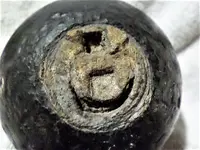Here are my professional qualifications for answering your question "Is this cannonball most likely safe now?"
I am recognized by the US Government (National Park Service) and various EOD units and Police bomb-squads as an expert on the subjects of civil war artillery projectiles, and how to make them safe/inert. I've "inerted" (a.k.a. deactivated) more than 1,000 civil war artillery shells during the past 40 years, including several for the National Park Service when park rangers found them at civil war battlefield parks.
Your cannonball is a civil war yankee-made 12-Pounder (4.62-inch) caliber Common-Shell utilizing a Bormann timefuze. Your report of its weight being "just under 9 pounds" tells me it contained only gunpowder (a Common-Shell), not a Case-Shot shell, which contained antipersonnel balls. From your description, the inerting drillhole is about 3/8-inch in diameter, which is the typical size for inerting civil war shells, and is sufficient for removing the gunpowder bursting-charge inside the shell. Because you say you can "insert a wooden pick in [the hole, all the way] up to the fuse", I am sure that your shell has been sufficiently emptied. People who drill civil war shells do not put a hole in the shell's body without flushing out the powder-cavity with water. The water dissolves the key ingredient (saltpeter/potassium-nitrate) in black gunpowder which makes it explosive. You might be able to insert a curved wire into the drillhole and scrape out a few remaining bits of the SPOILED powder... but without the saltpeter ingredient it will not "flash." However, if you are still worried, I suggest you fill the shell with water, let it soak overnight, and pour it out, so you can feel satisfied that any remaining saltpeter is gone.
I can also state with authority that unlike 1880s-to-present artillery shells, excavated civil war shells will NOT explode from being dropped... or even being hit with a hammer. The proof is that we civil war relic hunters have dug up about 100,000 civil war shells, and there is no record of even ONE exploding during the digging-up process. We almost always hit the shell with the shovel during the digging. The only people in the past 100 years who have been killed (two) or injured (three) by a civil war shell exploding were using a power-tool on the shell. So if you don't do that, or heat the shell to 572-degrees Fahrenheit (the ignition temperature of black gunpowder), you need not worry about owning a civil war artillery shell.






